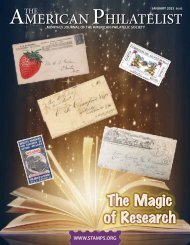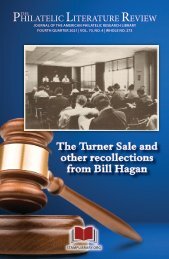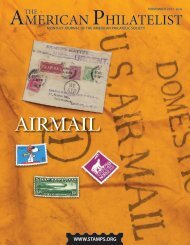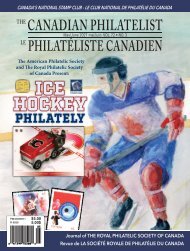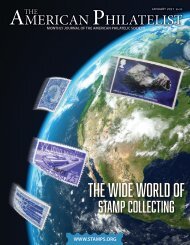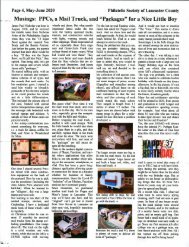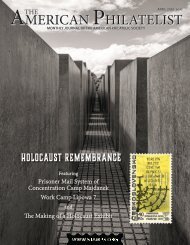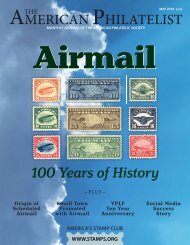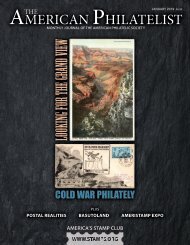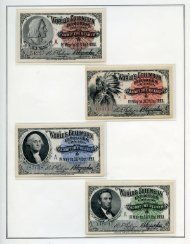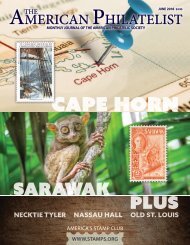August 2018 - Sneak Peek
The American Philatelist is the monthly journal of the American Philatelic Society, the world's largest organization for stamp collectors and enthusiasts. Members receive the printed magazine and can access the digital edition as a benefit of membership in the Society. Please enjoy this sneak peek. We're confident that once you see all that we offer, you'll want to join the APS today.
The American Philatelist is the monthly journal of the American Philatelic Society, the world's largest organization for stamp collectors and enthusiasts. Members receive the printed magazine and can access the digital edition as a benefit of membership in the Society. Please enjoy this sneak peek. We're confident that once you see all that we offer, you'll want to join the APS today.
You also want an ePaper? Increase the reach of your titles
YUMPU automatically turns print PDFs into web optimized ePapers that Google loves.
“representing a new constellation.” With the addition of Vermont<br />
in 1791 and Kentucky in 1792, the 1794 Flag Act specified<br />
that the flag should have 15 stripes and 15 stars.<br />
The expansion of the Union to 20 states by 1817 required<br />
a rethinking of the flag’s configuration. Rather than increasing<br />
the number of stripes every time a new state joined the<br />
union, the Flag Act reduced their number to 13, signifying<br />
the original 13 colonies, and increased the number of stars<br />
to reflect the current number of states in the Union. The act<br />
specified that a new star would be added on the Fourth of July<br />
following the admission of a new state.<br />
The United States flag has had 50 stars since July 4, 1960,<br />
when a new star was added after Hawaii became the 50th<br />
state.<br />
“The U.S. Postal Service has a long history of displaying<br />
the American flag on our stamps,” said Patrick Mendonca,<br />
senior director, Office of the Postmaster General and CEO,<br />
who dedicated the stamp at the city’s Houdini Plaza. “Today,<br />
we celebrate the Flag Act of 1818, which established the<br />
framework of our country’s flag, and in the process gave birth<br />
to what has become a globally recognized symbol of independence,<br />
hope and pride.”<br />
Joining Mendonca to unveil the stamp were Tim Hanna,<br />
Appleton mayor; Greg Otis, chairman, Appleton Parade<br />
Committee; Corey Otis, Appleton Parade Committee member;<br />
and Erin Davisson and Tom Zalaski, news anchors,<br />
WFRV-TV 5 (CBS).<br />
More than 100 units – including floats, marching bands<br />
and military, service, fraternal, youth and commercial groups<br />
– participated in the parade to pay a patriotic tribute to the<br />
flag. Other unique elements included circus wagons and a<br />
living Iwo Jima monument. About 70,000 people attended<br />
the annual event.<br />
fruit ice dessert treats on a stick, were issued June 20, the day<br />
before the Summer Solstice, and dedicated in a ceremony at<br />
the Thinkery Children’s Museum in Austin, Texas. The firstclass<br />
forever stamps are being sold in booklets of 20.<br />
When scratched, a coating on the stamps emits a sweet,<br />
sugary aroma, which will add “the sweet scent of summer to<br />
letters of love, friendship, party invitations and other mailings”<br />
the USPS said in a news release.<br />
The artwork is by illustrator Margaret Berg, of Santa<br />
Monica, California, who depicted the whimsical illustrations<br />
in watercolors for her first stamp design. The words “Forever”<br />
and “USA” appear along the bottom of each stamp. Art director<br />
Antonio Alcalá of Alexandria, Virginia, designed the<br />
stamps with Leslie Badani of Alexandria, Virginia.<br />
The designs don’t necessarily show those favorites so familiar<br />
to baby boomers who consumed millions of them in<br />
the 1950s and ’60s. Today ice pops and treats are still made<br />
by large manufacturers, but home cooks and artisanal shops,<br />
now craft new flavors as well as old favorites. In recent years,<br />
frozen treats containing fresh fruit such as kiwi, watermelon,<br />
blueberries, oranges and strawberries have become more<br />
common. In addition, flavors such as chocolate, root beer<br />
and cola are also popular. Some frozen treats even have two<br />
sticks, making them perfect for sharing.<br />
The scratch-and-sniff technology is the latest twist in design<br />
and technology rolled out by the U.S. Postal Service over<br />
the past few years.<br />
In February, the USPS issued a set of 10 Bioluminescent<br />
Life stamps in panes of 20. The stamps used a reflective ink that<br />
caused the images on the stamps to shine and glow. In June<br />
(also noted in this column), the USPS issued three high value<br />
stamps featuring the Statue of Freedom atop the Capitol Building.<br />
Those stamps have added security features via printing.<br />
Frozen Treats<br />
The U.S. Postal Service issued its first scratch-and-sniff<br />
postage stamps on the eve of summer with a booklet of Frozen<br />
Treats stamps.<br />
The stamps, with each showing two fanciful ice cream or<br />
In 2017, the USPS issued eight Have a Ball stamps and a<br />
single Total Solar Eclipse stamp, each with innovations. The<br />
Have a Ball stamps were the first U.S.-issued touch-and-feel<br />
stamps in which the stamps had the feel of the sports ball<br />
shown. Six days later, on June 20, the Postal Service issued the<br />
AUGUST <strong>2018</strong> / AMERICAN PHILATELIST 807




